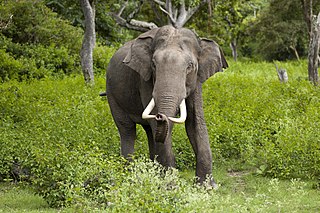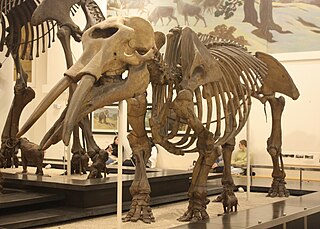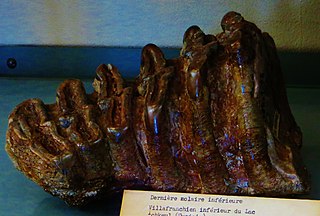
A mammoth is any species of the extinct elephantid genus Mammuthus. They lived from the late Miocene epoch into the Holocene until about 4,000 years ago, with mammoth species at various times inhabiting Africa, Asia, Europe, and North America. Mammoths are distinguished from living elephants by their spirally twisted tusks and in at least some later species, the development of numerous adaptions to living in cold environments, including a thick layer of fur.

Proboscidea is a taxonomic order of afrotherian mammals containing one living family (Elephantidae) and several extinct families. First described by J. Illiger in 1811, it encompasses the elephants and their close relatives. Three living species of elephant are currently recognised: the African bush elephant, the African forest elephant, and the Asian elephant.

A mastodon is a member of the genus Mammut, which was endemic to North America and lived from the late Miocene to the early Holocene. Mastodons belong to the order Proboscidea, the same order as elephants and mammoths. Mammut is the type genus of the extinct family Mammutidae, which diverged from the ancestors of modern elephants at least 27–25 million years ago, during the Oligocene.

Elephantidae is a family of large, herbivorous proboscidean mammals collectively called elephants and mammoths. In some cases, all members of the family can be referred to as elephants. They are large terrestrial mammals with a snout modified into a trunk and teeth modified into tusks. Most genera and species in the family are extinct. Only two genera, Loxodonta and Elephas, are living.

Gomphotheres are an extinct group of proboscideans related to modern elephants. First appearing in Africa during the Oligocene, they dispersed into Eurasia and North America during the Miocene and arrived in South America during the Pleistocene as part of the Great American Interchange. Gomphotheres are a paraphyletic group ancestral to Elephantidae, which contains modern elephants, as well as Stegodontidae.

Deinotheriidae is a family of prehistoric elephant-like proboscideans that lived during the Cenozoic era, first appearing in Africa, then spreading across South Asia and Europe. During that time, they changed very little, apart from growing much larger in size; by the late Miocene, they had become the largest land animals of their time. Their most distinctive features were their lack of upper tusks and downward-curving tusks on the lower jaw.

Palaeoloxodon recki, often known by the synonym Elephas recki, is an extinct species of elephant native to Africa and West Asia from the Pliocene or Early Pleistocene to the Middle Pleistocene. During most of its existence, the species represented the dominant elephant species in East Africa. The species is divided into five roughly chronologically successive subspecies. While the type and latest subspecies P. recki recki as well as the preceding P. recki ileretensis are widely accepted to be closely related and ancestral to Eurasian Palaeoloxodon, the relationships of the other, chronologically earlier subspecies to P. recki recki, P. recki ileretensis and Palaeoloxodon are uncertain, with it being suggested they are unrelated and should be elevated to separate species.

Australopithecus bahrelghazali is an extinct species of australopithecine discovered in 1995 at Koro Toro, Bahr el Gazel, Chad, existing around 3.5 million years ago in the Pliocene. It is the first and only australopithecine known from Central Africa, and demonstrates that this group was widely distributed across Africa as opposed to being restricted to East and southern Africa as previously thought. The validity of A. bahrelghazali has not been widely accepted, in favour of classifying the specimens as A. afarensis, a better known Pliocene australopithecine from East Africa, because of the anatomical similarity and the fact that A. bahrelghazali is known only from 3 partial jawbones and an isolated premolar. The specimens inhabited a lakeside grassland environment with sparse tree cover, possibly similar to the modern Okavango Delta, and similarly predominantly ate C4 savanna foods—such as grasses, sedges, storage organs, or rhizomes—and to a lesser degree also C3 forest foods—such as fruits, flowers, pods, or insects. However, the teeth seem ill-equipped to process C4 plants, so its true diet is unclear.

Anancus is an extinct genus of "tetralophodont gomphothere" native to Afro-Eurasia, that lived from the Tortonian stage of the late Miocene until its extinction during the Early Pleistocene, roughly from 8.5–2 million years ago.

Phosphatherium escuillei Gheerbrant, Sudre et Cappetta 1996 is a basal proboscidean that lived in Africa during the early Eocene, by 56-55 Ma. It is one of the earliest known proboscidean, together with Eritherium azzouzorum from the Selandian. It was found in phosphorites beds from the base of the Ypresian stage of the Ouled Abdoun Basin, which is best known for its exceptionally rich marine vertebrate fauna.

The Chad National Museum is the national museum of Chad. Since November 2010, the national heritage has been highlighted in modern premises opposite the Palace of January 15, seat of the National Assembly, and next to an identical building housing the National Library.

Mammuthus africanavus is a species of mammoth known from remains spanning the Late Pliocene-Early Pleistocene found in Central and North Africa in the countries of Chad, Morocco, Tunisia and Algeria. It was originally described by Camille Arambourg in 1952 based on remains found around Lake Ichkeul in north Tunisia as a species of Elephas. Some specimens from this sample may genuinely represent Elephas rather than Mammuthus, though the holotype has been argued to likely represent a true mammoth. Some authors have argued that the species should be placed in Loxodonta, reflecting the difficulty in distinguishing the teeth of early elephantids. It is distinguished from the earlier Mammuthus subplanifrons by having a higher number of ridges/lamellae on the teeth, which display a greater parallelity, the molars being more hypsodont, with the molars having a greater amount of cementum and thinner enamel, and the molar plates exhibit closer spacing.

Stegotetrabelodon is an extinct genus of primitive elephantid from the Late Miocene to Early Pliocene of Africa, the Arabian Peninsula, and Italy.

Primelephas is a genus of Elephantinae that existed during the Miocene and Pliocene epochs. The name of the genus suggests 'first elephant'. These primitive elephantids are thought to be the common ancestor of Mammuthus, the mammoths, and the closely allied genera Elephas and Loxodonta, the Asian and African elephants, diverging some 4-6 million years ago. It had four tusks, which is a trait not shared with its descendants, but common in earlier proboscideans. The type species, Primelephas gomphotheroides, was described by Vincent Maglio in 1970, with the specific epithet indicating the fossil specimens were gomphothere-like. Primelephas korotorensis is the only other species to be assigned to the genus. All fossils found of the Primelephas have been found in Africa, primarily in modern day Chad, Tanzania, Kenya, Ethiopia, and Uganda.

Notiomastodon is an extinct genus of gomphothere proboscidean, endemic to South America from the Pleistocene to the beginning of the Holocene. Notiomastodon specimens reached a size similar to that of the modern Asian elephant, with a body mass of 3-4 tonnes. Like other brevirostrine gomphotheres such as Cuvieronius and Stegomastodon, Notiomastodon had a shortened lower jaw and lacked lower tusks, unlike more primitive gomphotheres like Gomphotherium.

Gondolin Cave is a fossiliferous dolomitic paleocave system in the Northwest Province, South Africa. The paleocave formed in the Eccles Formation dolomites. Gondolin is currently the only described hominin-bearing fossil site in the Northwest Province-portion of the designated Cradle of Humankind UNESCO World Heritage Site. The cave is located on privately owned land and is not accessible to the public. As is the case with other South African Paleo-cave systems with Pliocene and/or Pleistocene fossil deposits, the system was mined for lime during the early 20th century. As a result, the system has been heavily disturbed and consists of only a small active cave, a series of in situ remnant cave deposits, and extensive dumpsites of ex situ calcified sediments produced during mining activities.
Selenetherium is an extinct genus of elephantid proboscidean. The type and only species is Selenetherium kolleensis, known from an incomplete mandible. It was found in the early (Zanclean) Pliocene sediments of Kolle, Chad.

Protarctos is an extinct genus of basal ursine bear that lived in North America and Eurasia during the Pliocene and into Early Pleistocene.
Huracan is an extinct genus of agriotheriin ailuropodine from the Neogene period. Fossils were found from North America and Eastern Asia. Unlike its modern relative the giant panda, which is a bamboo specialist, Huracan was a hypercarnivorous genus of bear that had adaptations for cursoriality.

Phanagoroloxodon is a genus of extinct elephant. It is known from one species, Phanagoroloxodon mammontoides, which is described from a partial skull from Russia, of probable Late Pliocene-Early Pleistocene age.





















